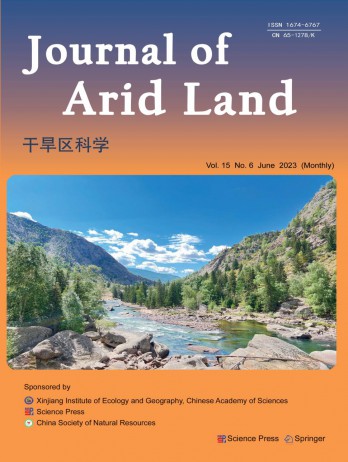发表咨询:400-888-9411 订阅咨询:400-888-1571

Journal of Arid Land杂志简介
《Journal of Arid Land》(简称JAL)是中国科学院新疆生态与地理研究所和科学出版社联合主办、科学出版社出版的自然科学综合性学术季刊。
《JournalofAridLand》刊登干旱和半干旱地区水、土、生物、气候等自然资源变化及其大气圈、水圈、生物圈、岩石圈之间的相互作用和与人类活动的关系,干旱和半干旱地区地理、生态和环境格局及生态建设和环境保护,干旱和半干旱区域对全球变化的响应与反馈机制等原创性、综合性、理论性和实用性的研究成果.
《Journal of Arid Land》本刊还开展中亚地区资源环境、生态安全及区域可持续发展的国际学术交流;同时刊登上述方面的研究评述、快讯、学术动态及本领域重要参考书书评等。本刊主要设有学术论文、专题评述、研究简讯、学术动态、书评等五个栏目,以国内外从事干旱区自然地理、生物、土壤/土地资源、环境、气候、水文水资源、社会科学等方面研究的专家学者,以及这些领域教学和学习的大专院校的教师和学生为读者对象。
《Journal of Arid Land》于2009年第四季度创刊,目前,在国际上被俄罗斯《文摘杂志》(AJ)VINITI数据库、波兰《哥白尼索引》(Indexof Copernicus,IC)和美国《乌利希期刊指南》(Ulrich’s Periodicals Directory)收录,在国内被《中国核心期刊(遴选)数据库》、《中国学术期刊网络出版总库》收录,并在《中国科技期刊网》、《中国科学院科技期刊开放获取平台》、《干旱区科学》域名网站等网络平台上全文。
Journal of Arid Land发文方向
学术论文、专题评述、研究简讯、学术动态、书评
Journal of Arid Land杂志特色
Keywords: Immediately after the abstract, provide 3 to 7 keywords, closely related to the subject of the article. Avoid general and plural terms and multiple concepts (e.g., 'and', 'of').
Introduction: Provide an adequate background. State the significance, objective and method of the research, citing necessary references, especially references of work published in the last two to three years.
Study area/materials and methods: Introducing a general idea of the study area or experimental setting, the materials and methods used and the basic progress of the study. Provide sufficient detail to allow the work to be reproduced or substantiated.
Methods already published should be indicated by a reference.
Results: Relating the findings and results of the observation(s) and experiment(s) without interpreting their meaning. Results should be clear and concise.
Discussion: Explaining all of your observations within your experiment(s). Exploring the significance of the results, but do not repeat them in the text. Stating whether each of your hypotheses are supported, rejected or if you cannot make a decision with confidence, and suggesting future studies or modifications to the same study.
Conclusions: Presenting main conclusions of the study that may stand alone or creating a discussion subsection.
Acknowledgements: Acknowledgements should include, if applicable, information on grants received, funding organizations, and/or recognition of people who assisted in the research or article.
References: Please cite a reference to acknowledge sources of information from others’ research and results. Ensure that
every reference cited in the text is also present in the reference list. Citation guidelines are as follows: as (Smith, 1998) for single author, as (Smith and Miller, 1999) for two authors, and as (Smith et al., 2006) for three or more authors. Groups of references should be listed first chronologically, then alphabetically. In the reference list, references should be arranged first alphabetically, then chronologically, if necessary. More than one reference from the same author(s) in the same year must be identified by the letters "a", "b", "c", etc., placed after the year of publication. Journal names should not be abbreviated.
Reference examples:
Articles: Ames R N, Reid C P P, Porter L K, et al. 1983. Hyphal uptake and transport of nitrogen from two 15N-labelled
sources by Glomus misseae, a vesicular-arbuscular mycorrhizal fungus. New Phytologist, 95(3): 381−396.
Monograph: Lambers H, Stuart Chapin ΙΙΙ F, Pons T L. 2008. Plant Physiological Ecology. 2nd ed. New York: Springer Science+Business Media, 56−64.
Proceedings: Bernstein N, Kafkafi U. 2002. Root growth under salinity stress. In: Waisel Y, Eshel A, Kafkafi U. Plant Roots,
the Hidden Half. New York: Marcel Dekker Press, 787−805.
Electronic reference: UNESCO World Heritage Centre. 2008. Operational Guidelines for the Implementation of the World
Heritage Convention. Paris: UNESCO World Heritage Centre. [2009-11-17].
杂志收录与荣誉
Journal of Arid Land杂志数据统计注:由于版面限制,此处仅列出部分数据信息,了解详情请联系客服 了解详情 >>
年度期刊评价报告 (本刊综合数据对比及走势)
名词解释:
影响因子:指该期刊近两年文献的平均被引用率,即该期刊前两年论文在评价当年每篇论文被引用的平均次数
被引半衰期:衡量期刊老化速度快慢的一种指标,指某一期刊论文在某年被引用的全部次数中,较新的一半被引论文刊载的时间跨度
期刊他引率:他引率是指,此期刊被引用次数中,被其他刊引用次数所占的比例
引用半衰期:指某种期刊在某年中所引用的全部参考文献中较新的一半是在最近多少年时段内刊载的
平均引文率:在给定的时间内,期刊篇均参考文献量,用以测度期刊的平均引文水平,考察期刊吸收信息的能力以及科学交流程度的高低
杂志被引半衰期、引用半衰期
杂志影响因子、被引次数
杂志发文量、期刊他引率
杂志平均引文率
我们提供的服务
在线客服
一对一咨询服务、简单快捷、省时省力
了解更多 >快递配送
直邮到家、实时跟踪、更安全更省心
了解更多 >杂志订阅
去除中间环节享受低价,物流进度实时通知
了解更多 >杂志推荐
正版杂志,匹配度高、性价比高、成功率高
了解更多 >期刊导航
常见问题
免责声明
若用户需要出版服务,请联系出版商,地址:新疆乌鲁木齐市北京南路818号,邮编:830011。
相关期刊
- Chinese Medical Journal
- Journal of Energy Chemistry
- Journal of Environmental Sciences
- Chinese Journal of Integrative Medicine
- Chinese Journal of Chemistry
- Asian Journal of Andrology
- Journal of Computer Science and Technology
- Chinese Journal of Mechanical Engineering
- Journal of Integrative Plant Biology
- Chinese Journal of Aeronautics